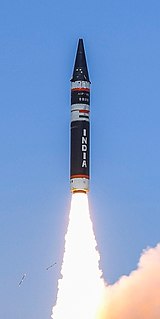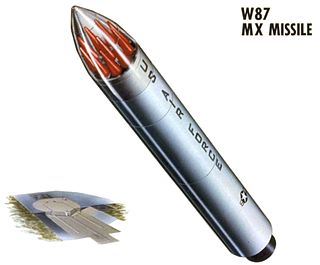Related Research Articles

An intercontinental ballistic missile (ICBM) is a missile with a minimum range of 5,500 kilometres (3,400 mi) primarily designed for nuclear weapons delivery. Similarly, conventional, chemical, and biological weapons can also be delivered with varying effectiveness, but have never been deployed on ICBMs. Most modern designs support multiple independently targetable reentry vehicles (MIRVs), allowing a single missile to carry several warheads, each of which can strike a different target. India, Russia, the United States, China and, France are the only countries that have operational ICBMs.
A neutron bomb, officially defined as a type of enhanced radiation weapon (ERW), is a low-yield thermonuclear weapon designed to maximize lethal neutron radiation in the immediate vicinity of the blast while minimizing the physical power of the blast itself. The neutron release generated by a nuclear fusion reaction is intentionally allowed to escape the weapon, rather than being absorbed by its other components. The neutron burst, which is used as the primary destructive action of the warhead, is able to penetrate enemy armor more effectively than a conventional warhead, thus making it more lethal as a tactical weapon.

A multiple independently targetable reentry vehicle (MIRV) is an exoatmospheric ballistic missile payload containing several warheads, each capable of being aimed to hit a different target. The concept is almost invariably associated with intercontinental ballistic missiles carrying thermonuclear warheads, even if not strictly being limited to them. By contrast, a unitary warhead is a single warhead on a single missile. An intermediate case is the multiple reentry vehicle (MRV) missile which carries several warheads which are dispersed but not individually aimed. Only the United States, the United Kingdom, France, Russia and China are currently confirmed to possess functional MIRV missile systems. Pakistan and India are developing MIRV missile systems. Israel is suspected to possess or be in the process of developing MIRVs.
The Air-Sol Moyenne Portée is a French nuclear air-launched cruise missile. In French nuclear doctrine it is called a "pre-strategic" weapon, the last-resort "warning shot" prior to a full-scale employment of strategic nuclear weapons. The missile's construction was contracted to Aérospatiale's Tactical Missile Division, now part of MBDA. The missile cost $600 million to develop.
The Hadès system was a short-range ballistic pre-strategic nuclear weapon system designed by France, as a last warning before use of strategic nuclear weapons, in the perspective of a Soviet invasion of Western Europe. It was designed from July 1984 as a replacement for the tactical road-mobile Pluton missile. Initially 120 missiles were planned to be deployed.

In 1962, the U.S. Navy issued a requirement for a long-range high-precision air-to-surface missile. The missile, named the AGM-53A Condor, was to use a television guidance system with a data link to the launching aircraft similar to the system of the then projected AGM-62 Walleye.

The W47 was an American thermonuclear warhead used on the Polaris A-1 sub-launched ballistic missile system. Various models were in service from 1960 through the end of 1974. The warhead was developed by the Lawrence Radiation Laboratory between 1957 and 1960.

The W68 warhead was the warhead used on the UGM-73 Poseidon SLBM missile. It was developed in the late 1960s at Lawrence Livermore National Laboratory.

A nuclear triad is a three-pronged military force structure that consists of land-launched nuclear missiles, nuclear-missile-armed submarines, and strategic aircraft with nuclear bombs and missiles. Specifically, these components are land-based intercontinental ballistic missiles (ICBMs), submarine-launched ballistic missiles (SLBMs), and strategic bombers. The purpose of having this three-branched nuclear capability is to significantly reduce the possibility that an enemy could destroy all of a nation's nuclear forces in a first-strike attack. This, in turn, ensures a credible threat of a second strike, and thus increases a nation's nuclear deterrence.
The TN 71 is a French-built thermonuclear warhead which was used on submarine-launched ballistic missiles in Redoutable class ballistic missile submarines.
The French airborne nuclear warheads (TN81) is a thermonuclear warhead carried by the Air-Sol Moyenne Portée (ASMP) medium-range air-to-surface missile, a component of the Force de frappe French nuclear deterrent. The warhead was introduced in 1988. By 1991, 80 warheads had been produced.
The TN 70 is a French-built thermonuclear warhead which was used on submarine-launched ballistic missiles in Redoutable class ballistic missile submarines.
The MR 41 is a French-built thermonuclear warhead to be launched with the M1 and M2 missiles in Redoutable class ballistic missile submarines.
The TN 61 was a French nuclear warhead.
TN 80 was deployed between 1985 and 1991 as the warhead of the ASMP air-to-surface missile carried by the Dassault Mirage IVP bomber. The yield was 300 kt, and it was hardened against nuclear defense missiles.
The TN 90 was a variable yield thermonuclear warhead developed by France for the Hadès tactical missile, designed to replace the AN 51/Pluton system. Development began in 1983, and production in 1990. However, following the collapse of the Soviet Union, production was halted after only 30 of an intended 180 warheads were built, and they were immediately put into storage. The Hadès missiles, and their TN-90 warheads, were retired, along with all French land-based missiles, in 1996. By the end of 2000 the TN 90's were at CEA Valduc waiting to be disassembled.

The M20 was a French submarine-launched ballistic missile (SLBM) deployed on the nuclear Redoutable-class submarines from 1977. It was withdrawn from service by 1991.
Tête nucléaire océanique is a French thermonuclear warhead intended for use on the M51.2 submarine-launched ballistic missile that is being developed and built by the Division of Military Applications (DAM) at France's Commissariat à l'énergie atomique et aux énergies alternatives. It will be carried on Triomphant-class submarines. The TNO is intended to replace the currently deployed TN 75 warhead. Its commissioning was planned for 2015, when France's newest submarines, either Le Terrible or Le Vigilant, will be one of the first to carry the warhead.
The French Airborne nuclear warhead (TNA) is a thermonuclear warhead carried by the Air-Sol Moyenne Portée Amélioré (ASMPA) medium-range air-to-surface missile, a component of the Force de frappe French nuclear deterrent. The warhead was introduced in 2010. 54 warheads had been produced replacing former TN 81 warhead carried by former Air-Sol Moyenne Portée Amélioré (ASMP) medium-range air-to-surface missile.
References
- Norris, Robert, Burrows, Andrew, Fieldhouse, Richard "Nuclear Weapons Databook, Volume V, British, French and Chinese Nuclear Weapons, San Francisco, Westview Press, 1994, ISBN 0-8133-1612-X